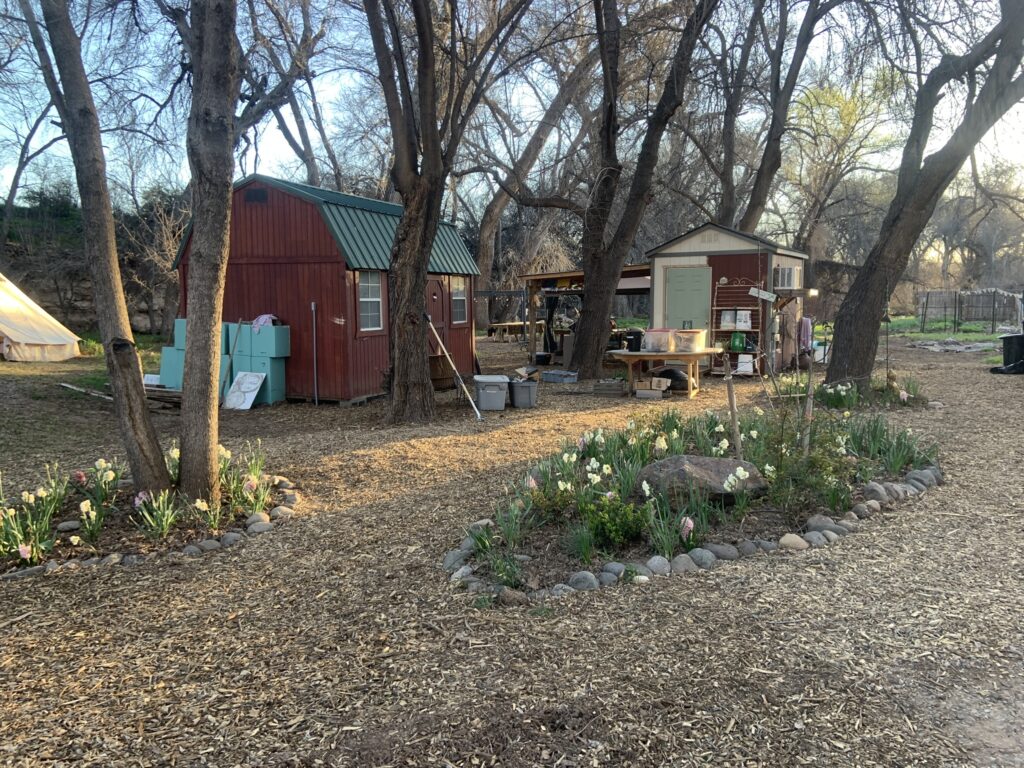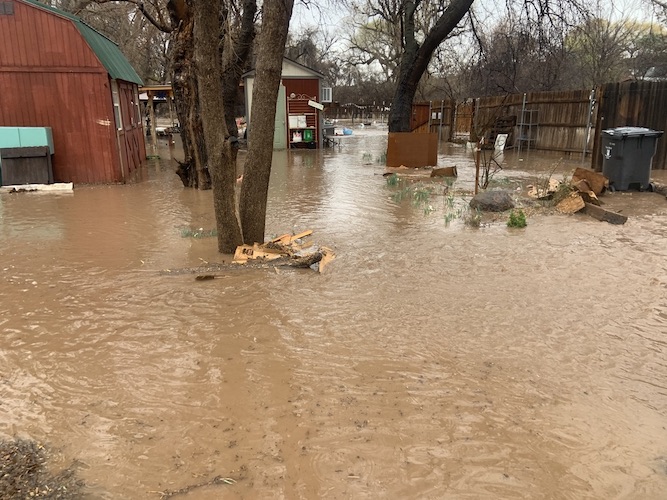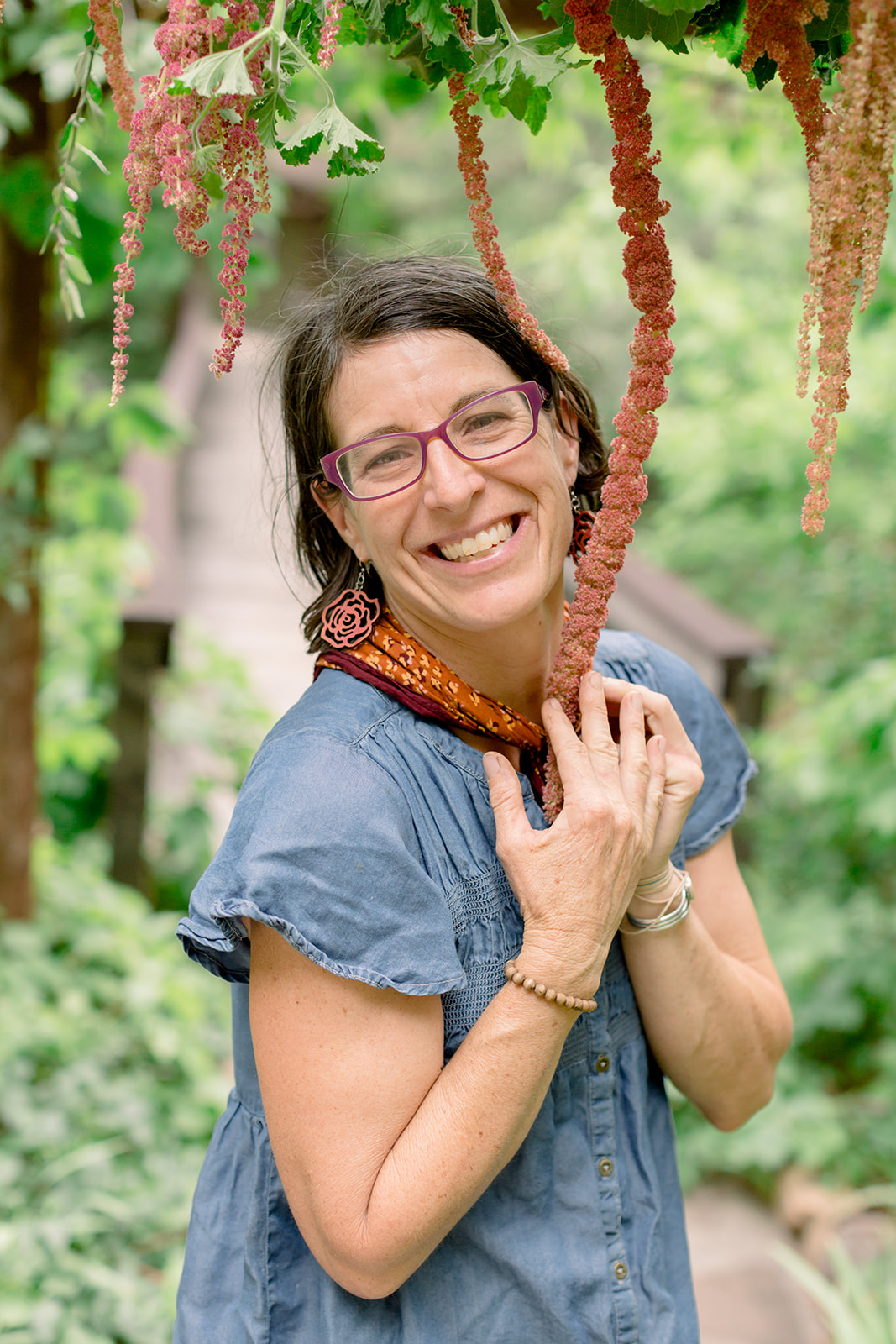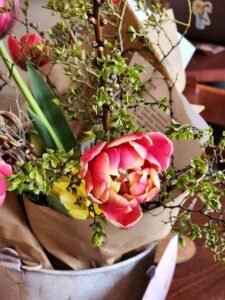 On the spring equinox, I was in the midst of arranging bouquets for the first week of my spring flower share when flood waters rose rapidly. Beaver Creek is across the street, 500 feet from our farm gate, and was steadily becoming more fierce from rain on top of snowmelt pummeling down from Flagstaff. Within minutes we were considering evacuation, as our entire street and the lower half of our farm was consumed by the river.
On the spring equinox, I was in the midst of arranging bouquets for the first week of my spring flower share when flood waters rose rapidly. Beaver Creek is across the street, 500 feet from our farm gate, and was steadily becoming more fierce from rain on top of snowmelt pummeling down from Flagstaff. Within minutes we were considering evacuation, as our entire street and the lower half of our farm was consumed by the river.
We escaped with our dog, our WWOOFer volunteers (Willing Workers on Organic Farms), fixings for dinner, and buckets of flowers. The flowers were remnants of pre-flood peace, as I harvested daffodils in a light drizzle that did not feel malicious. They bore a rain-soaked mistiness, as if recalling a distant memory.
I gathered the elements from what felt like a previous life, which I had to wade through calf-deep water to retrieve from my she-shed. Double tulips in a variegated pink and pale creamy yellow almost the color of sunrise and new beginnings. On high ground in a friend’s driveway, I packaged these bright faces together as a prayer for our farm, and our neighborhood, including a poem titled “Hope,” by Rosemary Wahtola Trommer.
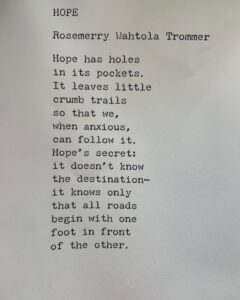 What is your plan B for when things go terribly wrong? This is not a question we ask ourselves very often, but the reality of living with climate change is that the one thing we can count on is change.
What is your plan B for when things go terribly wrong? This is not a question we ask ourselves very often, but the reality of living with climate change is that the one thing we can count on is change.
The next morning we returned to the farm and the waters had receded. In the midst of surveying the damage, a second wave of flooding consumed the land again. This time it was faster, deeper, scarier. We evacuated again and I escaped to the normalcy of flower deliveries in Sedona. On the Cornville road the sun was shining through low clouds, while Oak Creek was flooding over the bridge and I was diverted through Page Springs. The angst was quelled by sharing flowers with our customers. I bought fancy chocolate, homemade bread, and radicchio to treat our farm-ily in exile and our host to a pasta dinner. Good food always provides immense comfort, care, and communion.
We cooked dinner together at our Rimrock friend’s house, who is herself a former flower farmer. Over a bottle of wine, she told us farm stories from twenty years ago, and we laughed at the absurd things that this occupation requires. I wondered what I would be doing in twenty years. What stories will I be telling?
The mind, like an arrow, shoots straight to fear. What will the flood take away? What will it destroy? I wondered if our farm, the buildings, and everything I have been working for would still be there in the morning.
We bought this farm at the start of 2020 and barely saw a speck of rain the first year. We weathered a brutally hot monsoon-less summer followed by a mild winter. In the past six months, we have experienced two floods, from two different directions. Many of us are coping with the realities of extreme and more frequent weather events. The question arises: is it possible to live here? How do we adapt and become pliant like the willows that bend in the flood to form new roots and shoots?
Surveying the damage, we were fortunate. Our house and the office were safe. The farm outbuildings are full of a thin coat of silt, but all the contents are salvageable and the structures are not permanently damaged. The same cannot be said for some of our neighbors who lost their living space, belongings and a sense of peace. The latter is the most difficult thing to replace.
The miracle is that our plants survived and remained rooted. They demonstrate the resilience and hope I have in nature. After being submerged by a rushing river current for nearly two days, they rose up. Plants have such a strong will to live, to survive, to reach for the light.
The cheerful daffodils have dirty faces and yet still emanate an uplifting, lively fragrance. They seem to be saying: “Don’t think of everything that has been undone! Think of all you received!”
The list of gratitudes grows each day. For Lonnie and Whitney, our WWOOF volunteers who stayed calm and helpful throughout the flood even though their worldly possessions (located in their vehicles) were at risk. They rolled up their sleeves to redo work that had been done the day before with grace.
I am grateful for the flood of concern, love and prayers that flowed almost immediately. Like a watershed, it came from tributaries of our community; friends, family and fellow flower farmers, our social media clan, our neighbors. This care uplifted my spirit and floated me through.
The cleanup has largely been joyful. A Sunday work party of our farm-ily, friends, employees and their families repaired the fallen fence to keep out the marauding javelinas, raked debris and spread piles of wood chips on the muddy pathways.
I watched as people carefully dusted off the faces of all the new ranunculus leaves, helping their green shine through. Friends chatted away while propping up the flattened garlic with damp leaves from the flood, admiring all the worms. I served a pot of chili beans with a giant farm salad and iced tea. We sat in the orchard surveying all this small army of loved ones completed in such a short time frame, and plants and people alike glowed with the accomplishment. The spring sun shined on the field, the fresh mulch, the now standing fence and I felt held by so much love. Working the earth together and sharing nutritious food from the land is the communion of spirit.
Rivers and watersheds connect us. We cannot ignore what happens upstream, and our actions impact lives downstream. The river carried away our amendments, compost, mulch piles and few farm seasons of tears, sweat and plans. It brought debris, destruction, rich soil, new seeds and wisdom of place.


